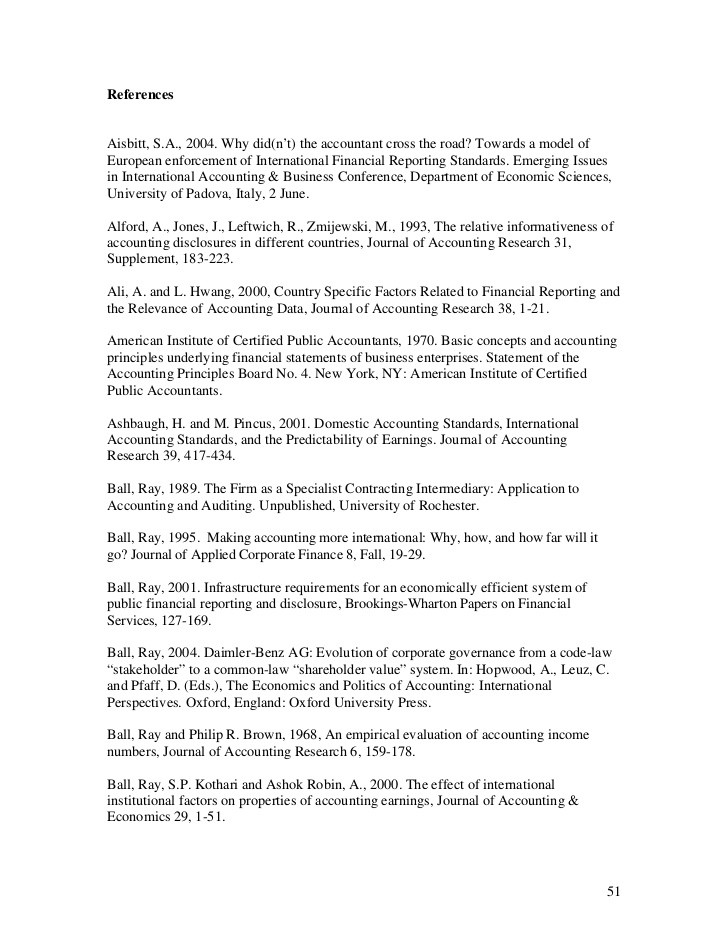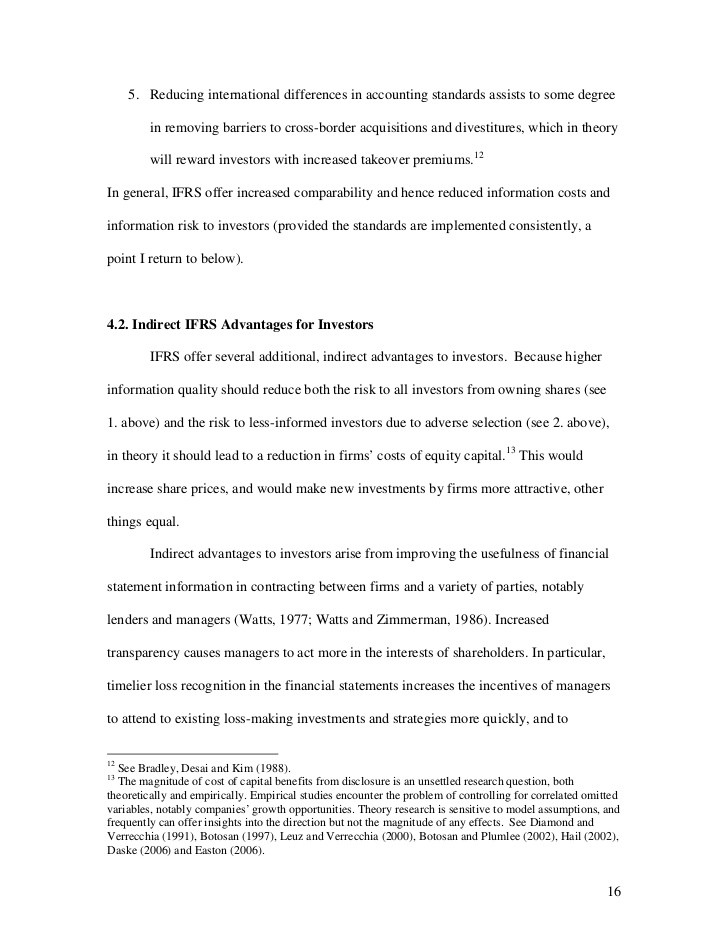What Will The International Financial Reporting Standards (IFRS) Mean to Businesses and Investors
Post on: 10 Июнь, 2015 No Comment

What Will The International Financial Reporting Standards (IFRS) Mean to Businesses and Investors?
Questions remain about the likelihood of U.S. IFRS adoption.
On August 27, 2008, the Securities and Exchange Commission (SEC) announced a roadmap for a complete change in U.S. accounting standards. If the roadmap is adopted, U.S. companies will have to change from the countrys existing accounting rulebook to International Financial Reporting Standards (IFRS) in 2014. Under the SEC plan, some very large firms (most likely multinationals) may adopt the new standards as early as 2009. While in recent weeks market turmoil has grabbed headlines, the underlying change in accounting rules could have a deeper and longer lasting impact. If the change goes well, it could usher in easier access to capital for U.S. and foreign firms, lower the costs for U.S. firms operating overseas, and simplify accounting for companies worldwide.
What are the new standards and how have they evolved?
International Financial Reporting Standards (IFRS) were developed by the International Accounting Standards Committee (IASC) and its successor organization, the International Accounting Standards Board (IASB). Because of the standards identification with these bodies, IFRS is sometimes referred to as IAS GAAP. A note about terminology: Generally Accepted Accounting Principles (GAAP), either U.S. or IAS, are a set of documents that specify the accounting principles and guidelines that companies use to prepare their financial statements, which are the main way companies communicate with their investors and other stakeholders. GAAP documents give guidance on what component statements should be shown within the published financial statements, how the figures in the financial statements should be calculated, and what notes and additional details should be included.
Although it seems like a major step to replace one set of accounting principles with another, it should be noted that any GAAP is a constantly evolving set of principles. Over the last 10 years, U.S. GAAP has seen complete rewrites in the accounting for mergers and acquisitions and in the accounting for derivatives and hedges, as well as major changes in 28 other areas.
Will the Roadmap Happen?
The SEC has been fairly aggressive in pursuing a convergence agenda thus far. Since November 2007, the SEC has allowed foreign firms to report under IFRS only, without requiring any U.S. GAAP adjustments, a move estimated to have saved affected firms as much as 2.5 billion Euros over time. [1] To be fair, requiring foreign firms to supply less data is never going to foment much opposition. The next stage actively compelling U.S. firms to change their reporting method will be more difficult to achieve.
For investors, the new standards will require an adjustment in how they interpret earnings numbers. For government, it will require ceding some regulatory power to an international body. The gain will be improved access to international capital; however, this is no benefit to the many smaller firms uninterested in international capital, which, in any case, is a difficult benefit to quantify. Adopting IFRS will also require businesses to conduct a one-off reworking of accounting records (at an administrative cost), and it may increase corporate tax payments, due to the last in, first out (LIFO) conformity rule, which will be discussed below. Companies with multinational operations will benefit by saving on the ongoing costs of annually converting their foreign reports to U.S. GAAP, but purely domestic companies will have no such countervailing benefit.
With many participants in the process quite committed, change looks more likely than not. But the political process, including the forthcoming general election, may delay or even halt the transition. The SECs roadmap includes one obvious get out clause: the commission will decide in 2011 whether convergence is in the public interest and would benefit investors. [2]
How Will IFRS Differ from U.S. GAAP?
Principles over Rules
IFRS is characterized as more principles based than U.S. GAAP, which is seen as largely rule based. However, it should be noted that any GAAP is, by definition, a set of principles. U.S. GAAP gives substantial discretion to managers in determining the assumptions behind their accounting statements, even on such basic items as depreciation timescale and inventory costing methods, decisions that can influence annual income by hundreds of millions of dollars for large firms.
The age of U.S. GAAP (resulting in a larger body of policy than that of the younger international accounting standards organizations) and the voracious appetite of U.S. accounting practitioners for official guidance and clarifications of standards (principally as an insulation against liability in the highly litigious United States) are responsible for much of the rule-based characteristics of U.S. GAAP. If IFRS is adopted in America, the demand for guidance will likely not abate. As companies seek guidance on specific situations, standard-setters may feel pressured to expand the IFRS rulebook, thus eroding its principles-based nature. It may also create additional demand for accountants and accounting experts.
Similarities and Differences

Although there is much discretion in U.S. GAAP and IFRS, there are some marked distinctions that will force different treatments on U.S. companies, or make new methods available to U.S. firms. Some of these changes are discussed below note that this is intended to be a representative sample of differences rather than an exhaustive list of the differences between the two sets of standards. Citigroup reports there are as many as 426 total differences, [3] but in many areas there is little divergence. For example, the issue of the marking to market of financial assets (especially hard to value assets such as mortgage backed securities) is one area that has attracted attention in the current credit crisis, but the IFRS standard (IAS 39) is similar to the U.S. GAAP standard (contained in FAS 157, FAS 133, and others). (Incidentally, both standards are being relaxed or reinterpreted see Clarifications on Fair Value Accounting and EU Relents on Some Mark-to-Market Accounting .)
Inventory Valuation Conventions
The most frequently discussed difference between IFRS and U.S. GAAP is in the treatment of inventory costing. U.S. GAAP allows the LIFO assumption, which expenses the most recently purchased inventory (last in) as a cost of goods sold expense first (first out), to be used for inventory costing. As prices tend to rise in most industries, this practice results in a high cost of goods sold expense, thereby depressing profits. Nonetheless, most U.S. companies use the LIFO method because it conveys tax advantages, and due to a unique conformity rule if the company uses LIFO in tax accounting, it must also use the harsh method in financial accounting. Under IFRS, LIFO is not allowed at all. Unless the SEC seeks an exception for U.S. firms something which the U.S. Financial Accounting Standards Board has advised against or unless the U.S. Internal Revenue Service scraps the conformity rule, U.S. companies will be forced to discontinue LIFO. While the result will be increased net income, it will ultimately be a disadvantage to stockholders because companies will be charged more corporate taxes. This tax penalty could be in the hundreds of millions of dollars for some large industrial firms and is seen as a major impediment to IFRS adoption.
Discretion in the Valuation of Assets
IFRS gives management more discretion in the area of asset valuation as a whole discretion that is also likely to increase company income. In the area of research and development costs and the related area of homegrown intangible assets valuation, IFRS is more generous than U.S. GAAP. IFRS allows development costs, but not basic research costs, to be included in the companys assets and, therefore, not expensed against income. U.S. GAAP insists that all research and development costs are expensed, except in extremely limited industry-specific circumstances.
Additionally, under U.S. GAAP, writing assets down due to impairment (i.e. permanent decreases in value), is a one-way process. Once written down, there is no way that an asset can be written back up, even if economic or industry circumstances improve. IFRS, on the other hand, does allow write-ups, and allows them to benefit income. Moreover, under U.S. GAAP, an acquired asset can never be increased in value as a result of market appreciation. In contrast, based on a long-lived but rarely used UK GAAP convention, IFRS allows assets to be written up in line with market values, as long as the revaluation is carried out with regular frequency. However, the increase in book value does not represent an increase in net income. With IFRS, there is also flexibility in many areas of standard setting, whereby more than one accounting treatment is allowed, although usually, only one treatment is described as the preferred or benchmark treatment.
Effect on Income
In many areas, IFRS is less conservative than U.S. GAAP, meaning that it allows an increase in the risk of overstating income in a companys financial statements. IFRS also allows more flexibility than U.S. GAAP, and since bonus and stock option schemes usually give managers incentives to increase income, this flexibility likely will be used to increase income more often than it will be used to decrease income. It is important to note that income is always an estimate, based on management judgments such as the useful life of long-term assets, the expected losses from bad debts, the expected costs of warranties, and the diminution of large assets such as the value of equipment and the value of accounting goodwill. It can be argued that the income estimate under U.S. GAAP has no more intrinsic validity than the estimate under IFRS. However, setting aside the question of intrinsic validity, it is fairly clear that switching from U.S. GAAP to IFRS will lead to many companies reporting higher income numbers, even while holding cash flows constant. European companies quoted on U.S. markets provide a natural laboratory since they were required to report in both U.S. GAAP and IFRS until very recently. Citigroup London analyzed 73 of the largest European companies quoted in the U.S. and found that 82 percent of the firms reported higher income under IFRS than under U.S. GAAP. [3] [4]














